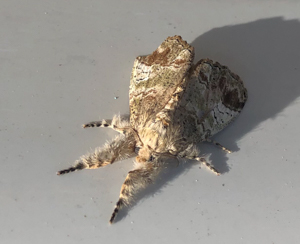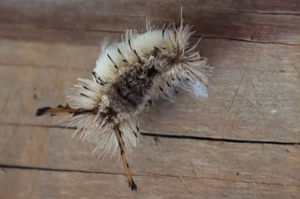Florida Moths
Bella Moth - Utetheisa ornatrix
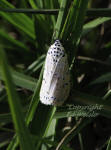
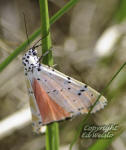
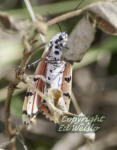
The Bella moths wing pattern is extremely variable, it is however the only moth in Florida that has a pink and yellow forewing with rows of black spots ringed in white. The hindwing is pink with an ragged black border.
The Bella moth or Rattlebox moth as it is also called, is diurnal or active during the day rather than nocturnal like most other moths. Adult moths have a 1 3/4 inch or less wingspan.
Bellas generally breed the year-round in Florida. Host plants are believed to be limited to members of the Crotalaria (Rattlebox) family of plants, the larva stores the alkaloids it receives from these plants making it toxic to potential predators, a trait that carries over to the adult moth.
Adult Bella moths concentrate around Rattlebox plants, there are two native species of Rattlebox, one is Avon Park rattlebox - C. avonensis the other is Rabbitbells - C. rotundifolia.
Southern Pink-striped Oakworm Moth - Anisota virginiensis pellucida
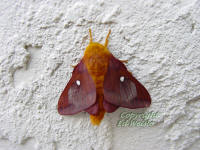
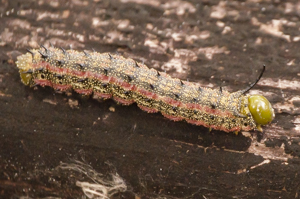
This moth has three flights in Florida and the caterpillar occurs in numbers large enough to defoliate the Oak trees they infest.
The Pink-striped Oak worm larvae are greenish brown with four pink stripes. Females moths are larger than the males, wingspan is from 1 5/8 to 2 5/8 inches.
Adults of this species do not feed and are active during the day. Female (dorsal side) is orange with pale purple at the margins of the wings, males are dark brown with red on the hind wing and has a translucent white spot on the fore wing. Host plants are various Oak (Quercus) species, with the heaviest infestations occurring in late summer through the fall.
Polka-Dot Wasp Moth - Syntomeida epilais
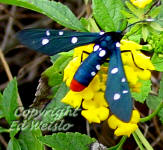
Also called the Oleander moth after the Oleander shrub, a common larval host plant. This brightly colored moth mimics the colors and patterns of a wasp to ward off potential predation by birds.
The day flying Oleander moth is iridescent blue on its wings and abdomen with a bright orange tipped tail end, symmetrical white spots on its wings and two white spots on its sides. The caterpillars feed ravenously on the Oleander shrub and can defoliate entire plants. Females emit ultrasonic signals to attract their mates rather than releasing pheromones like most moths.
Grape-leaf Skeletonizer Moth - Harrisina americana
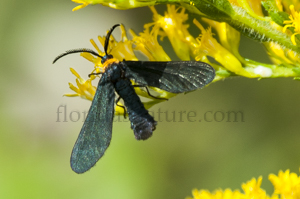
Ranges throughout Florida and the eastern half of the U.S..
Adult wingspan 18-28 mm, length 8-12 mm. Wings are completely black and are held away from the body when at rest. Orange to red collar, antennae are pectinate in both sexes, males antennae are also plumose. Tip of abdomen has a tuft of scales.
Adults fly March through October in Florida, with larvae present April through November. Larvae have a black head, yellow body with a black band encircling each abdominal segment.
Luna Moth - Actias luna
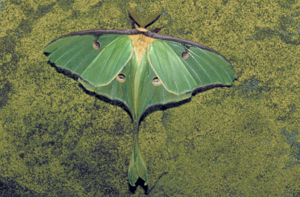
Wingspan from 4 1/2 to 7 inches. In Florida adults may be found during every month of the year,large green moths with a long tail on each hind wing and distal eye spots on both the fore and hind wings.
More southerly populations use a variety of host plants particularly members of walnut and hickorie, sumac, sweetgum, and persimmon. Villard (1975) lists hickory as the preferred host.
Adults have vestigial mouth parts and do not feed, relying instead on nutrients stored as a caterpillar. Having a short lifespan of 7 to 10 days and being nocturnal in nature this moth is seldom seen, although it is not rare.
Salt Marsh Moth - Estigmene acrea
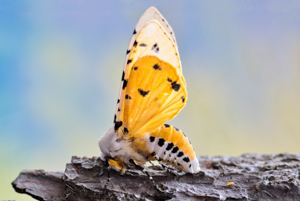
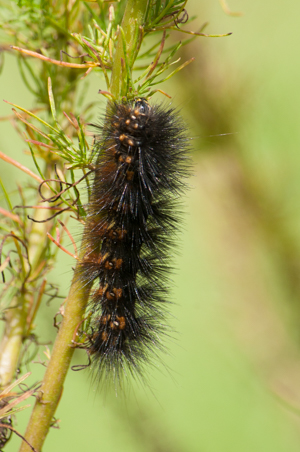
Caterpillars of the Salt Marsh moth are a pest on many vegetable and field crops. Females lay up to 1,200 eggs and the larvae disperse in search of food. Host plants in the wild include Pigweed, Anglepod, Dog Fennel and Ground Cherry.
Adults have up to about a 2 1/2 inch wingspan and are white with irregular black specks and five larger black spots, abdomen is dull orange, tip of abdomen is white in females.
Black-etched Prominent moth - Cerura scitiscripta
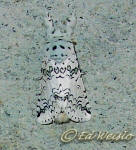
White moth with finely etched black lines in a zigzag pattern on the fore wing., this moth has a few dark scattered scales on, and along the rear margin of the hindwing.
First 2/3 of the antennae are bipectinate (comb like). Wingspan = 2.5 - 4.0 cm.. Larval hosts plants are members of the Poplar, Cherry and Willow trees.
Streaked Sphinx moth - Protambulyx strigilis
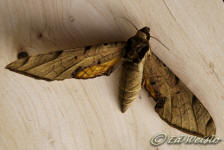
Large moth with a 4 1/4 to 5 1/4 inch wingspan, South Florida is the northern limit of its range.
There are two forms of Streaked Sphinx, a pale form and a dark form. The pale form is pale yellow-gray on the top of the fore wing., the hind wing is deep yellow-orange.
The dark form is reddish brown on top of the fore wing., the hind wing is orange-brown, both forms have a notch or indentation on the inner margin of the fore wing.
Adults fly in July, larval host are several members of plants in the cashew family.
Dot-lined White moth - Artace cribrarius
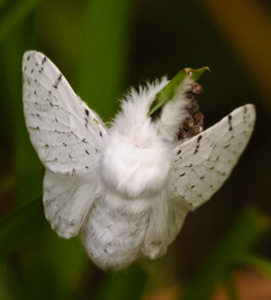
Nocturnal, adults are drawn to lights, flights from March though October in the south , adult wingspan from 25 to 62 mm., or from under an inch to almost two and a half inches, the males are smaller than the females. Wings are white with lines of black dots resembling a sieve - cribrarius is from the Latin "cribrum" or "the sieve".
Found in deciduous forests throughout Florida and the S.E., the caterpillars of the Dot-Lined White moth mimic twigs, they are mottled grey and white with black markings with a "fringe" of sub-lateral hair, larva feed on the foliage of roses, oaks and cherry.
Gaudy Sphinx moth – Eumorpha labruscae
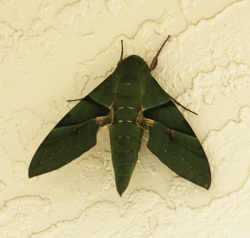
Family - Sphingidae.
Large green moth with a 4 3/4 inch wingspan, body and fore wing. are deep gray-green on upper, hind wing top has deep blue to purple patches with yellow borders and a red spot near the inner margin of the wing. Underside is greenish yellow and deep gray.
Host plants are grapes and Siam weed (Eupatorium odoratum). Range is north from Argentina through Mexico South eastern United states with strays as far north as Michigan.
Polyphemus moth - Antheraea polyphemus
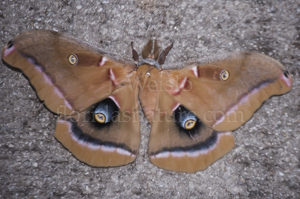
Family - Saturniidae (Giant silkworm and Royal moths)
Adult wingspan is 10 to 15 cm (approximately 4 to 6 inches) making this one of the largest silkworm moths in Florida.
Found from southern Canada down into Mexico and in all of the lower 48 states except for Arizona and Nevada, the Polyphemus moth is the most widely distributed of the large silk moths. Adult Polyphemus moths may be found year-round in Florida, while more northern states have 2 flights per year.
Juniper-twig geometer - Patalene olyzonaria
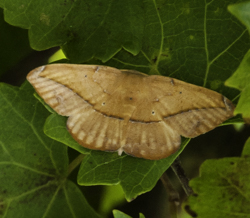
Family - Geometridae
A very large family of moths, with over 1400 species indigenous to North America. Their scientific name is in reference to the way their larvae, or "inchworms" appear to "measure the earth" as they move along in a looping fashion.
Ranging from Eastern Canada south to Florida and west to Texas, wingspan 1 1/4" - 1 1/2", color is variably brown to yellow-ish. Fore wing. hooked at tip. Habitat presumed to be successional pine/juniper woodlands, forest edges. Larvae feed on juniper, white cedar and possibly pine. 2-3 flights per year.
